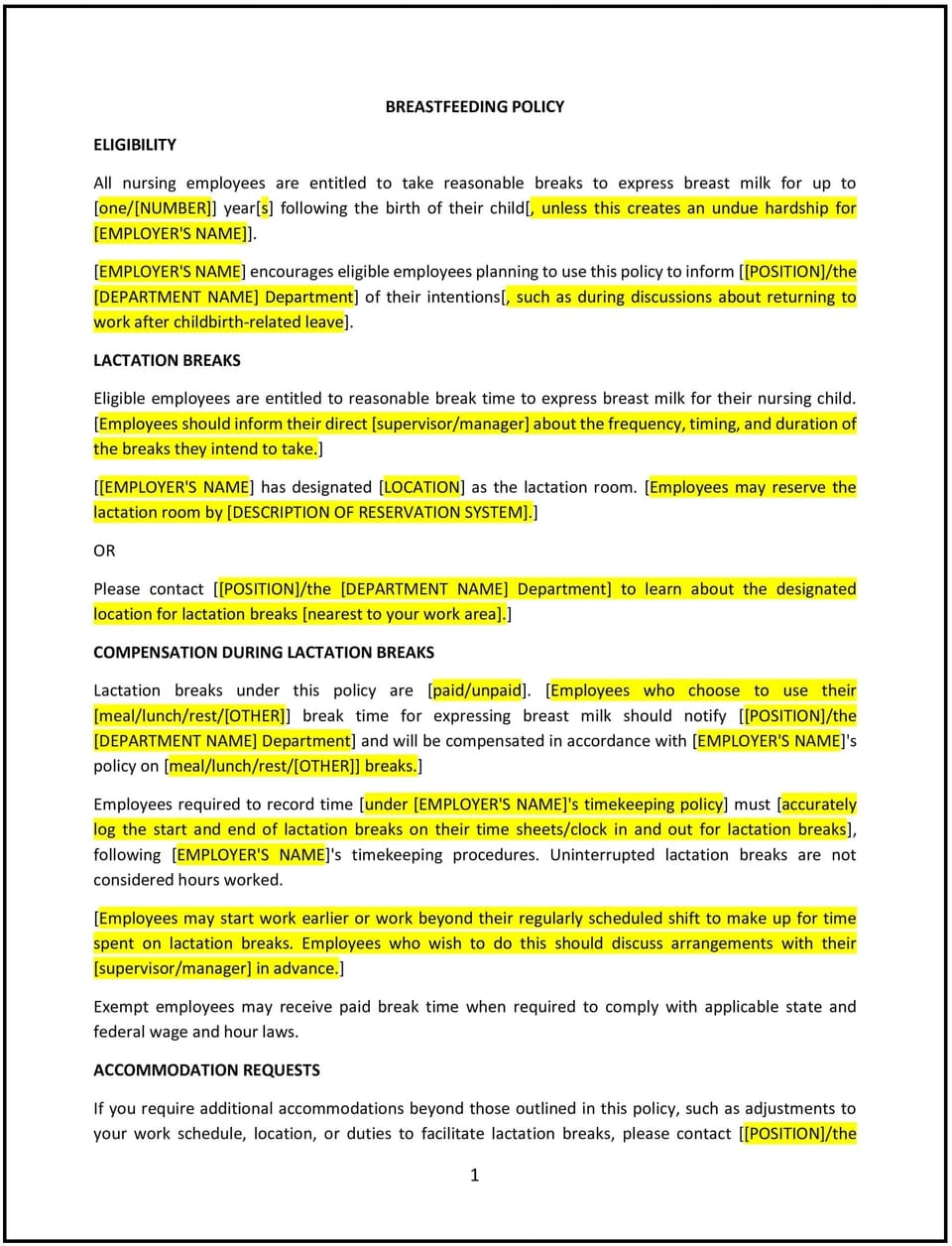Breastfeeding break policy (Idaho): Free template

Breastfeeding break policy (Idaho)
A breastfeeding break policy helps Idaho businesses support nursing employees by providing reasonable break time and a private space to express breast milk. This policy outlines the rights of employees, the duration and frequency of breaks, and the requirements for providing a suitable lactation space. It reflects the business’s commitment to fostering an inclusive and supportive workplace for working parents.
By implementing this policy, businesses can promote employee well-being, enhance workplace satisfaction, and align with federal and Idaho-specific guidelines.
How to use this breastfeeding break policy (Idaho)
- Define break time requirements: Specify the duration and frequency of breastfeeding breaks, typically allowing reasonable time as needed to express milk. Breaks should be in addition to regular meal or rest periods.
- Provide a suitable lactation space: Outline the requirements for a private, clean, and functional space that is not a bathroom. The space should include a chair, table, and access to an electrical outlet.
- Communicate the policy: Share the policy with employees during onboarding, training sessions, and through internal communications to ensure awareness and understanding.
- Train managers: Ensure supervisors understand the policy and are prepared to accommodate breastfeeding employees with sensitivity and professionalism.
- Document accommodations: Maintain records of breastfeeding break requests and accommodations to ensure consistency and transparency.
- Review and update: Regularly review the policy to ensure it remains aligned with employee needs, business operations, and any changes in federal or Idaho laws.
Benefits of using this breastfeeding break policy (Idaho)
This policy provides numerous benefits for Idaho businesses:
- Supports employee well-being: Providing breastfeeding breaks helps nursing employees balance work and personal responsibilities, promoting physical and emotional health.
- Enhances workplace satisfaction: A supportive policy demonstrates the business’s commitment to inclusivity and employee care, improving morale and job satisfaction.
- Improves retention: By accommodating working parents, businesses can increase employee loyalty and reduce turnover.
- Aligns with best practices: Offering breastfeeding breaks reflects modern workplace standards and can enhance the business’s reputation among employees and job seekers.
- Promotes inclusivity: The policy fosters a welcoming environment for working parents, contributing to a diverse and inclusive workplace culture.
- Reduces disruptions: Clear guidelines for breastfeeding breaks help minimize interruptions and ensure smooth operations.
- Provides clarity: A well-defined policy ensures consistent treatment of all employees and reduces potential misunderstandings.
Tips for using this breastfeeding break policy (Idaho)
- Communicate the policy effectively: Share the policy with employees during onboarding, training sessions, and through internal communications to ensure awareness.
- Train managers: Ensure supervisors understand the policy and are equipped to handle breastfeeding break requests with sensitivity and professionalism.
- Provide a comfortable space: Ensure the lactation space is private, clean, and equipped with necessary amenities, such as a chair, table, and electrical outlet.
- Offer flexibility: Accommodate employees’ schedules and needs by allowing flexible break times and durations.
- Document requests: Maintain records of breastfeeding break requests and accommodations to ensure consistency and transparency.
- Review the policy regularly: Update the policy as needed to reflect changes in employee needs, business operations, or federal and Idaho laws.
- Lead with empathy: Encourage a workplace culture where employees feel comfortable discussing their needs and seeking support.
Q: Why should Idaho businesses have a breastfeeding break policy?
A: A breastfeeding break policy helps businesses support nursing employees, promote inclusivity, and align with federal and Idaho guidelines.
Q: How much break time should businesses provide for breastfeeding employees?
A: Businesses should provide reasonable break time as needed to express milk, typically in addition to regular meal or rest periods.
Q: What kind of space should businesses provide for breastfeeding employees?
A: Businesses should provide a private, clean, and functional space that is not a bathroom. The space should include a chair, table, and access to an electrical outlet.
Q: Are breastfeeding breaks paid or unpaid?
A: Breaks for expressing milk are typically unpaid unless the employee uses existing paid break time. Businesses should clarify this in the policy.
Q: How should businesses handle breastfeeding break requests?
A: Businesses should accommodate requests with sensitivity and professionalism, ensuring employees have access to breaks and a suitable lactation space.
Q: What should businesses do if they lack space for a lactation room?
A: Businesses should make reasonable efforts to create a suitable space, such as converting a storage area or providing access to a nearby facility.
Q: How often should the policy be reviewed?
A: The policy should be reviewed annually or as needed to reflect changes in employee needs, business operations, or federal and Idaho laws.
This article contains general legal information and does not contain legal advice. Cobrief is not a law firm or a substitute for an attorney or law firm. The law is complex and changes often. For legal advice, please ask a lawyer.


